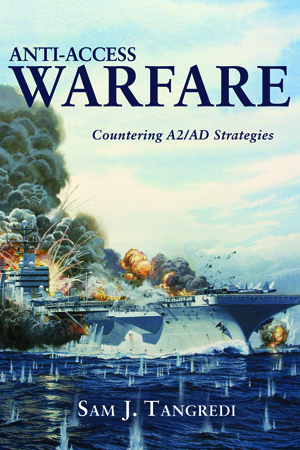
Anti-Access Warfare: Countering A2/AD Strategies By Sam J. Tangredi, Naval Institute Press, Annapolis MD, 2013
By Dr GREGORY P GILBERT
ANTI-access/area denial, or A2/AD as it is often abbreviated, has become one of the buzz phrases of recent defence debates. The story goes that as the US and its close allies withdraw from their Middle East commitments their militaries have moved away from counter-insurgency operations and pivoted to the Asia-Pacific region where the primary challenge is countering, if not breaking down, the anti-access/area denial strategies of nations such as China, North Korea and Iran.
The US air-sea battle concept is often seen as the operational and tactical counter to A2/AD, although few details of air-sea battle have been made available to the public. As a result Sam Tangredi’s book on Anti-Access Warfare: Countering A2/AD Strategies is very timely indeed.
Tangredi goes much further than the typical water-cooler chat that has tended to accompany the trendy A2/AD label. Anti-Access Warfare is much more than a review of military technology in such operations: it involves a fundamental rethink of anti-access concepts at the strategic level. Tangredi makes the point that anti-access is ‘an ancient concept’ that uses ‘techniques of strategy that have been used throughout military history.’ In this Tangredi is profoundly correct, A2/AD is really not new but is rather a new name for an old approach to war. Anti-Access Warfare starts by examining an ancient and a modern example – the Persian War of 480 BC and the Gulf War 1991 – to determine five fundamental elements that characterise the anti-access approach. In summary they are: the perception of strategic superiority of the attacking force, the primacy of geography, the predominance of the maritime domain, the criticality of information and intelligence, and the determinative impact of extrinsic events.
These five elements form a historical model of A2/AD at the strategic level which is then utilised by Tangredi when he discusses historical case-studies and modern anti-access strategies. Overall these five elements hold up to the extensive evaluation by Tangedi and hence represent fundamental truths of anti-access warfare − critics might suggest that this is not all that surprising as they are motherhood statements. The theoretical construct that underpins this book is rather illuminating and a rare departure from the standard group think. It is, however, presented in a manner that is both easy to read and comprehend.
Anti-Access Warfare also contains a wealth of information for the naval practitioner as well. The historical case-studies include three anti-access victories – the Spanish Armada 1588, the Dardanelles 1915 and the Battle of Britain 1940, as well as three anti-access defeats – the Nazi defence of Fortress Europe 1944, the Pacific War strategy of Japan 1942-45, and the Argentine attempt to defend the Falkland Islands 1982. Tangredi goes on to analyse four modern anti-access strategies in detail, using his fundamental elements to help develop the analysis and increase our understanding at the strategic level. These include chapters on East Asia (looking at China’s anti-access strategy), Southwest Asia (looking at Iran), Northeast Asia (North Korea), and Central Eurasia (Russia and the near abroad). Each of these modern case studies identifies possible ways that anti-access strategies may be broken down, like breaches in conceptual great walls, not necessarily by warfare or military action but often through a combination of other means. In fact Tangredi concludes that high technology weapons, such as the anti-ship ballistic missile (ASBM), do not revolutionise warfare by themselves. Historically it is the collective use of force by sea, air and on land (maritime forces) that are able to enact a superior offensive strategy often coupled with a flexible defence posture, to gain victory.
Some might cynically suggest that A2/AD will lose favour in coming years when it is replaced by the next defence fad acronym, but none-the-less Tangredi is correct to highlight the past historical examples and enduring nature of anti-access warfare. Modern maritime strategy supports this view when it describes sea denial as a sub-component of sea control. Unfortunately some recent military education has conflated the sea denial construct by limiting discussion of its use to the tactical and operational levels of conflict. In my opinion, anti-access warfare and A2/AD are nothing more than new terms for what should be understood as sea denial at the strategic level. The gaining of sea control in the maritime environment (which includes the littoral) may or may not contain a sea denial element, but a sea denial strategy without other maritime elements is rarely if ever a success.
Anti-Access Warfare is an excellent addition to the modern maritime strategy bookshelf. Like Mahan before him, Tangredi provides a rich tapestry of historical material that is applied to support his original strategic analysis. This work is directly relevant to our current struggle to safeguard the global maritime commons. This book provides clear thinking about future warfare options in the Asia-Pacific region, while avoiding the rather narrow perspectives found in other, more technology focused, works. Anti-Access Warfare is highly recommended.



